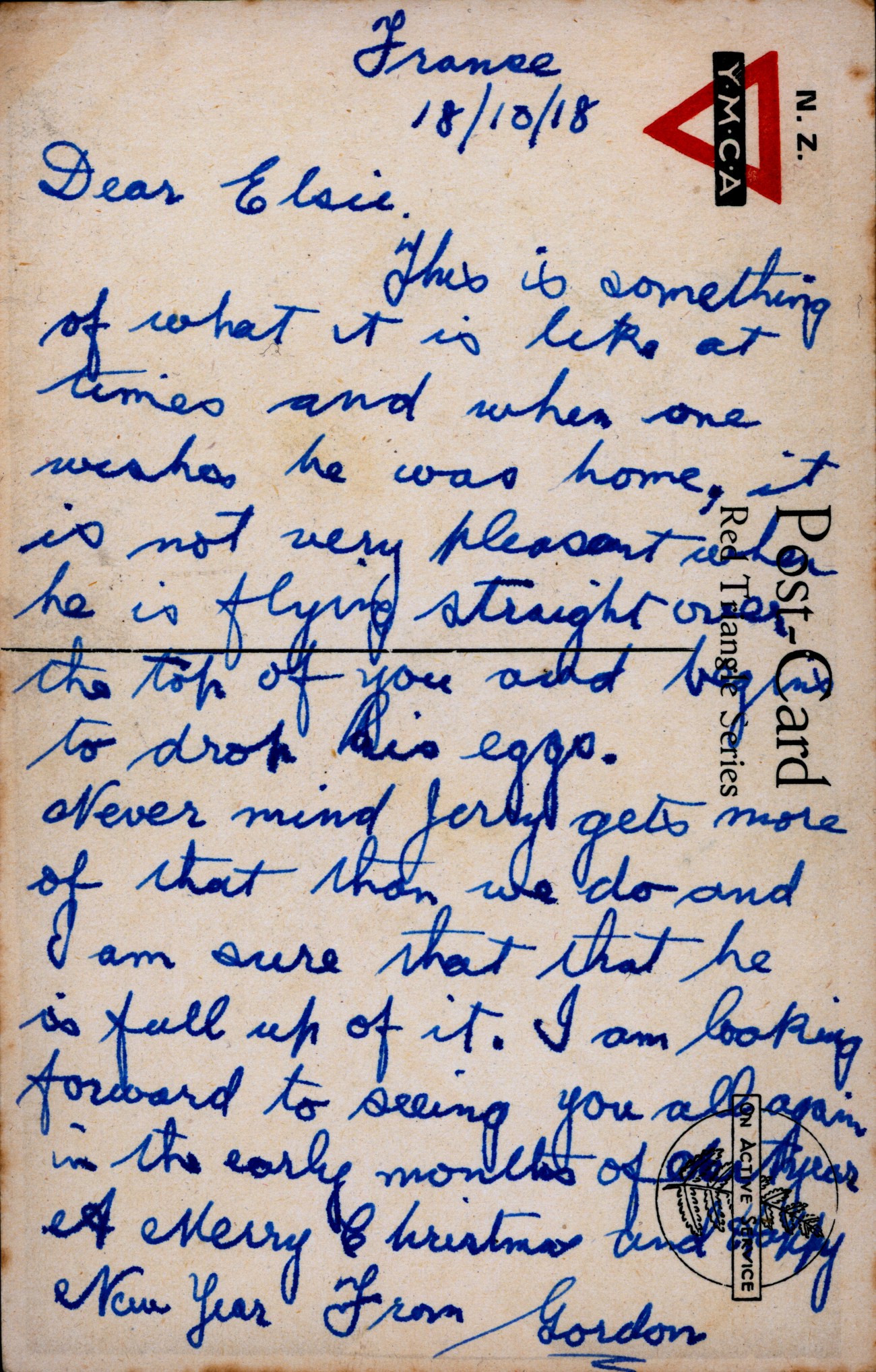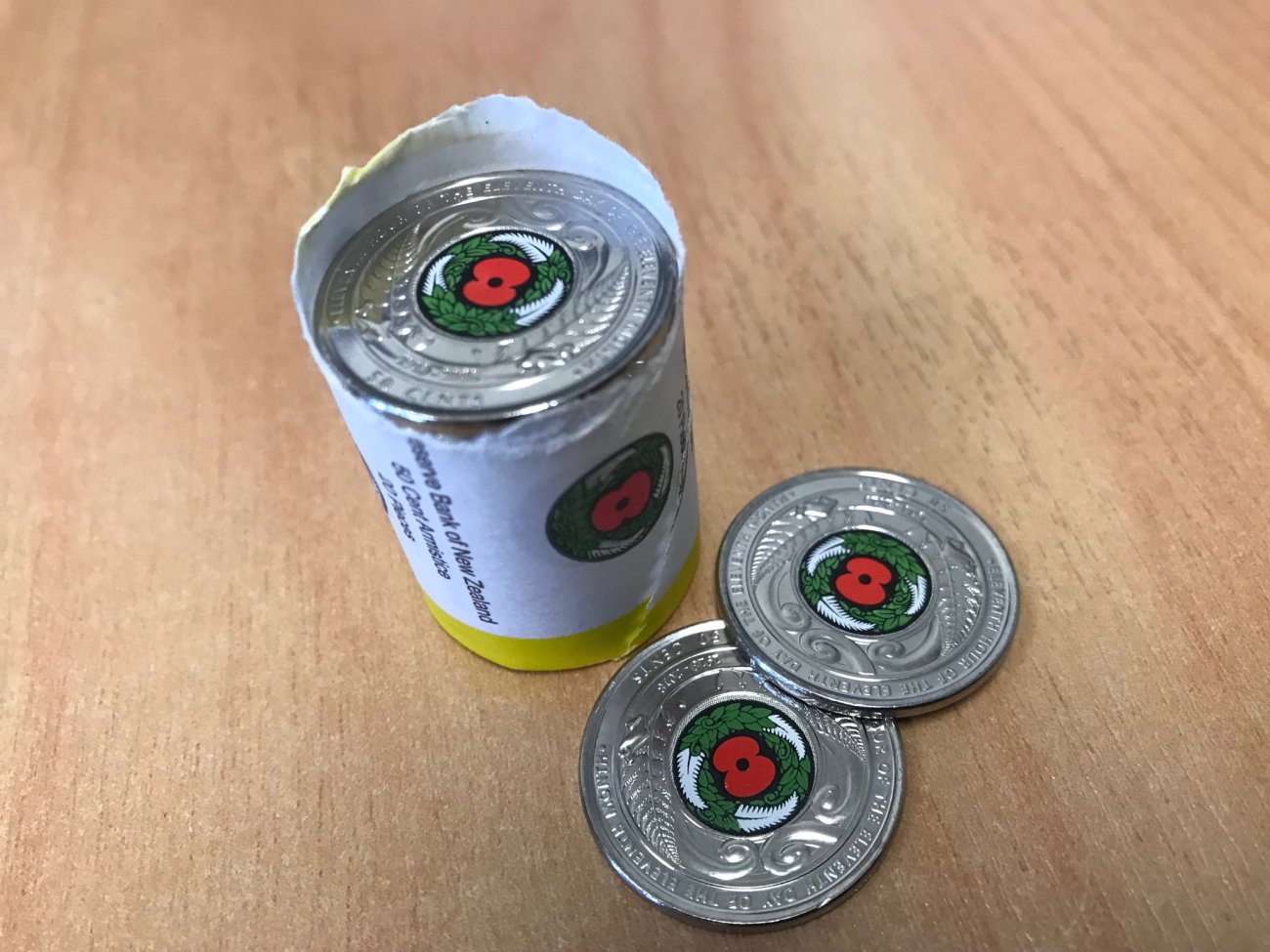I was browsing through my First World War postcard collection the other day and was prompted to share this one when I noticed the date. The message on the back of this card was written exactly one hundred years ago – on 18 October 1918. It gives us an insight into one of the many ordeals that troops had to endure. The helplessness of watching as an enemy aircraft approaches overhead and begins to drop its bombs.

First World War postcard showing a Hun Gotha on a Bombing Stunt. Lemuel Lyes Collection
This is one of a series of postcards sold by the New Zealand Y.M.C.A. Some of them are similar in tone to the works of Bruce Bairnsfather, using trench humour to confront some of the horrors that men faced on the front. They were popular among soldiers serving in France – so much so that examples like these aren’t difficult to find. One of the things that I like about them is that they often prompted soldiers to write candidly about some of their experiences. This is one such example.

Message from soldier written on reverse of postcard, 18 October 1918. Lemuel Lyes Collection.
France 18/10/18
Dear Elsie,
This is something of what it is like at times and when one wishes he was home, it is not very pleasant when he is flying straight over the top of you and begins to drop his eggs. Never mind Jerry gets more of that than we do and I am sure that that he is full up of it. I am looking forward to seeing you all again in the early months of next year. A Merry Christmas and Happy New Year.
From Gordon
Gotha was a German aircraft manufacturer, and the name ‘Gothas’ were given to their long-range bombers. They were famously used in air raids on English cities including London – ushering in a terrifying new age of aerial warfare. Their first successful attack on the capital killed more people than any other air raid on Britain in the First World War. More than any zeppelin raid. The following month King George V announced that his family was changing their name from Saxe-Coburg-Gotha to Windsor.
Troops on the Western Front also experienced the helplessness of being attacked by German bombers. These long-range aircraft added to the cacophony of death to those in the trenches and also made those further back vulnerable – including troops that thought themselves a safe distance from the front and nurses working in hospitals. New Zealander Elise Kemp was tragically killed during one such attack – she is believed to be the only New Zealand-born nurse killed in action on the Western Front.
Gordon seems pretty confident that he’ll be home early in the new year. The Allies were on the offensive and for once it really did look like the war might be over before Christmas. Turkey surrendered to the Allies just twelve days after the message on this postcard was written. Four days later Austria-Hungry also signed an armistice. Then eight days later, at 11am on the eleventh day of the eleventh month, Germany surrendered and the war was finally over.
I don’t know if Gordon survived the last month of the war or not. The New Zealanders were involved in fighting right up until the end – including the dramatic liberation of Le Quesnoy. Sadly the war didn’t end soon enough for many soldiers. Henry Nicholas, who was awarded the Victoria Cross for his actions at Polderhoek (see previous post here), was killed in action on 23 October 1918. According to this table, 766 New Zealanders died in October and another 647 in November. I like to think Gordon made it through though to return home and see Elsie again.
The Treaty of Versailles specifically demanded that Germany had to hand over all of their Gotha bombers to the Allies. It is ironic to note that in the Second World War a British heavy bomber was named the Vickers Windsor. The name that the royal family adopted after ditching Saxe-Coburg-Gotha. Only three examples were produced though and it never saw combat.
There are lots of commemorations planned for the centenary of the armistice. Here in New Zealand you can check out the WW100 site for ways to get involved. A two-minute silence will be observed at 11 a.m., followed by a ‘roaring chorus’. Churches will ring bells, music will be played, drivers will toot horns and thousands of dogs everywhere won’t have a clue what is going on but will probably join in too.

A roll of 50 cent ‘Armistice Day’ commemorative coins. © Lemuel Lyes
Some commemorative 50 cent coins have also been minted to mark the centenary so keep an eye out for them in your change, or if you are impatient like me then you can order them from here.
© Lemuel Lyes
Categories: Anniversaries, First World War
I am amazed you have time to ‘browse’ your collection. Filing things is nearly a full-time job and my primary thought is “one day I may actually get to look a this stuff…once…maybe.” Still haven’t got to filing anything from my February Trip. #Truth
I’m just lucky with my First World War postcards as most of them are organised in albums, so it is comparatively easy to look through them. The dream is to one day have the entire collection organised like that. It is a work in progress. A long way to go….
Outstanding, Lemuel. You have real treasures there.
Thanks! It is a privilege to be able to share them.
And, as always, it is great to see you again.
Likewise! Its been a busy year so I haven’t had as much time for my blog, but as always there is plenty in the wings waiting to be shared.
Glad to hear it!